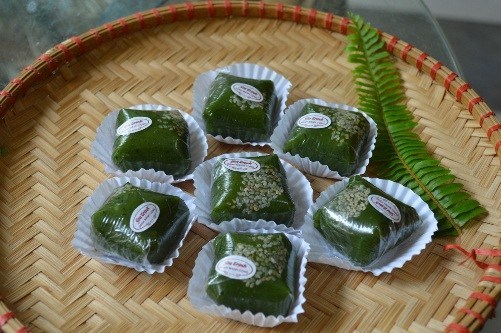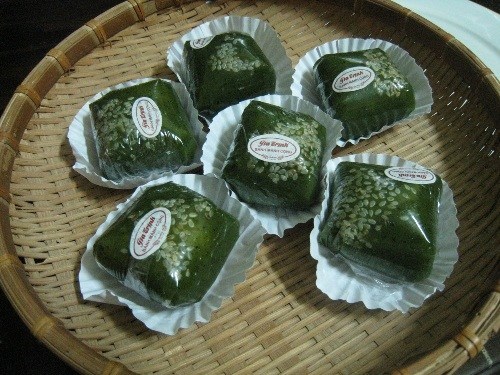What happiness!
It’s likes meeting up with old friends with whom you had lost them contact.
There is a cluster of Clinacanthus nutans leaves, which are so green, in the
corner of my grandmother’s house. My grand-mother usually uses the leaves and
the youngest part of the tree to cook a vegetable soup for me. Clinacanthus nutans leaves belongs to
Acanthaceae family and is usually grown in the wild along fences in rice field
or in gardens, particularly in the North.
Clinacanthus nutans soup has very good aroma and helps to
release heat from our bodies. At noon on
hot summer days or in the cold of winter it still makes a good appetizer and
the meal seems to finish quicker. My
grand-mother told me, “ Eating soup with clinacanthus nutans is like eating
crab or shrimp because there is a lot of calcium in it, which is very good for
bones. Children should eat more of this
to improve their health."

Clinacanthus nutans leaves and the cake, brought back a lot of childhood memories
My grandmother also makes tea with Clinacanthus nutans.
She cuts the Clinacanthus nutans plant into small segments and lets them dry,
then boils them with water to make the tea. She also makes “Bánh mảnh cộng” with green beans inside,
it tastes very moist and sweet, and has a good aroma. Villagers in my hometown
also use its leaves (after crushing it into small pieces) to treat sore eyes,
or pan fried either to eat or treat tendon problems, swollen joints and
fractures. If children feel pain when urinating they can drink clinacanthus
nutans tea to alleviate the symptoms . Because my grandmother’s children ate this calcium rich vegetable her
children have all grown up strong and healthy.
Time goes by so quickly and my grand-mother has passed away. My mother
and my aunt haven’t got enough time to learn how to
make this cake from my grand-mother yet so
it has been 20 years since I had a chance to try it again. In the cooking book
written by Mrs Van Dai there is a section that teaches you how to make “Bánh mảnh cộng”. I tried several times but couldn’t recreate
its authentic taste.
Once, in an ancient bakery shop, I saw a cake that was
dark green in color and smelled of Clinacanthus nutans leaves. I asked the old
lady there, if it was “Bánh mảnh cộng” ? She confirmed, and
said that she had made it. What
happiness! It’s likes meeting up with old friends that you haven’t seen for a
long time.
Her name is Vinh and she said that as well as “ Bánh mảnh cộng” she also makes: “Bánh dành dành”. This is a cake made
from Gardenia jasminoides Ellis flowers; “Bánh
gai” made from Boehmeria
nivealeaves; and “bánh gấc” made from Momordica cochinchinensis
fruit. These traditional cakes are not made by many people nowadays, but she
can make them all. She said if the cakes are machine-made they are never as be
delicious. She still makes cake in the traditional way, without additives, to
create a natural taste and smell.
At 16A Ly Nam De Street you will find a shop owned by Mrs
Pham Thi Hong Ha. This specializes in making traditional cakes. The shop is
called Gia Trinh. There are many kinds of cakes here: “Bánh mảnh cộng” cake; “Củ cải” a cake made of radish; “Bánh gai” made with Boehmeria
nivealeaves; “Bánh dành dành”
the cake mentioned above; “Bánh ít dừa”
sticky rice with green beans and coconut in the middle; “Khúc” cake sticky rice with green bean and pork in the middle; “Ngải cứu” made from Artemisia vulgaris L
leaves with peanuts and coconut inside;
“Bánh chưng” which is a square of sticky rice cake made specially for
Tet; “Bánh dày”; sticky rice in a
round shape and served with “Giò lụa”-steamed
mint pork; and “Bánh dẻo” which is a sticky
rice cake made from green beans.

“Bánh mảnh cộng” cake made by Gia Trinh who are specialized in making traditional cakes
Making “Bánh mảnh
cộng” isn’t very difficult. Blend the Clinacanthus nutans leaves then use
the juice to mix with sticky rice flour. Coconut is sliced into small strands
and mixed with green beans and sugar then placed in the middle. The mixture of
green bean, coconut, sugar brings a taste of sweetness and the fat to the dish.
This mixture is wrapped in a layer of sticky rice that is green in color and
smells of Clinacanthus nutans leaves. The cake is formed into a round shape and
wrapped in banana leaves before steaming.
After steaming the cake needs to be left to cool down,
the aroma leaves a warm feeling for everyone. After tasting, the flavor of the
sticky rice, leaves and green beans stayed on my tongue and brought back
childhood memories.
Mrs Ha Thi Hong Phan lives in Hang But St and recalled
the old days when her mother used to make cakes such as “Bánh gấc” or “Bánh mảnh cộng”.
She was less than 10 years old at that time but still wanted her mother to
teach her how to make them. “Bánh gấc”cake
was also made by a little girl named Hong Ha, it was very delicious, it had
good moisture and a very good aroma. This passion for making traditional cakes
has followed for decades. Hong Ha is now the owner of a famous bakery in Hanoi.
When you have a passion for traditional cakes you can’t
ignore the ingredients. Mrs Hong Ha brings leaves from Clinacanthus nutans,
Gnaphalium affine and Boehmeria nivea, together with Gardenia jasminoides Ellis
flowers and Momordica cochinchinensis fruit from her hometown to the city. When
there are not enough natural ingredients she grows them herself. All the cakes
are made with new flour, fresh leaves, flowers and fruits. These cakes have a
good smell of new sticky rice, new leaves and fresh green beans. Each of these small pieces of cake contains memories
of Hanoi from the old days.

Recently, Mr Hai Phuong Nguyen rediscovered recipes and
cooking methods for “Bánh mảnh cộng”
and asked food experts sample it to see if it maintained its authentic flavor.
After receiving comments from senior chefs and elderly people he returned home
and practiced again. He repeated the processes 10 times before he could finally
make “Bánh mảnh cộng” with its typical green color, the correct moisture and
aroma, and the rich taste of green beans. It also had the smoothness which is
critical in making “Bánh mảnh cộng”
"When cuisine
carries cultural factors, it represents the manners and morals of a
nation". Sometimes the simple things in life such as what you eat or
drink, is the source of life .
Happiness comes when the old traditions are preserved.
This simple thing means we are also preserving the roots of our hometown
and our country?
Followed
by V.H
Dan Tri Newspaper
Extracted
from articles written especially for Golden Spoon Contest 2014 called “A journey
to search for traditional rustic dishes”